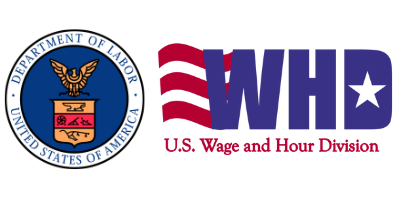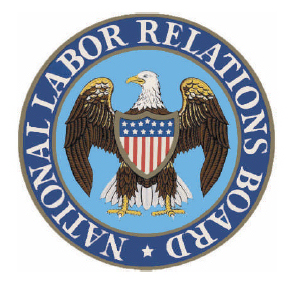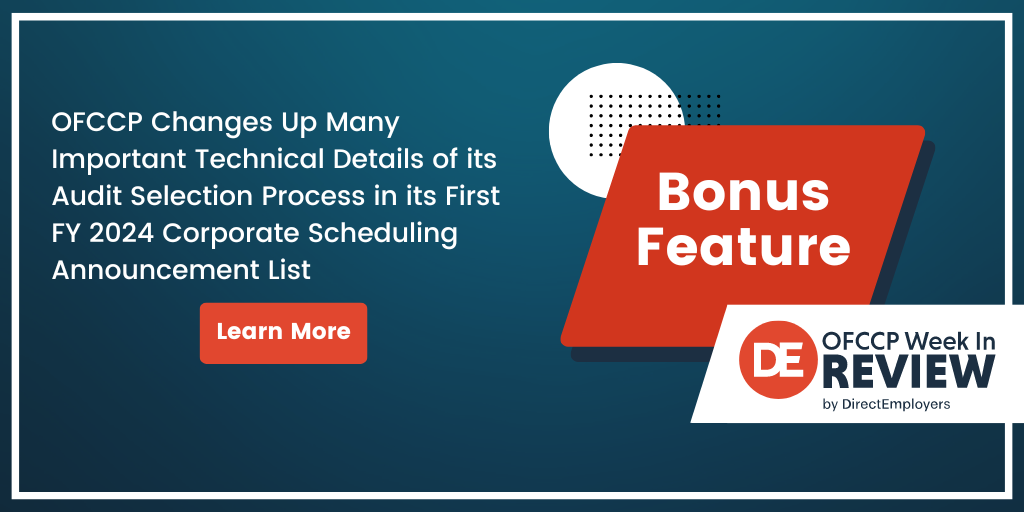
- JOLTS Report – Job Openings Decreased by 296k in April, Rate Decreased to 4.8%
- Employers Who Missed June 4th Deadline Now Have Until July 9 to File EEO-1 Survey
- OFCCP Changes Up Many Important Technical Details of its Audit Selection Process in its First FY 2024 Corporate Scheduling Announcement List
- U.S. Economy Added 272k Jobs in May, Unemployment Rate Edged Up to 4.0%
- In Brief
- Looking Ahead: Upcoming Date Reminders
Tuesday, June 4, 2024: JOLTS Report – Job Openings Decreased by 296k in April, Rate Decreased to 4.8%

The April job openings rate, at 4.8 percent, decreased from 5.0 percent in March. Job openings decreased in health care and social assistance (-204,000) and in state and local government education (-59,000) but increased in private educational services (+50,000).
Hires, Total Separations, Quits & Other Separations Up; Layoffs/Discharges Down; All Rates Unchanged
The number of hires in April was 5,640,000 compared to the adjusted 5,617,000 number for March (+23,000). The rate held steady at 3.6 percent.
Total separations were 5,372,000 for April, up from 5,330,000 for March (+42,000). The rate was unchanged at 3.4 percent.
Within separations, quits in April were 3,507,000, up from 3,409,000 in March (+98,000). The rate held steady at 2.2 percent.
Layoffs and discharges in April were 1,515,000, down from 1,601,000 in March (-86,000). The rate was unchanged at 1.0 percent.
The number of other separations was 349,000 in April, up from 320,000 in March (+29,000). The percentage rate held steady at 0.2.
BLS posted interactive graphs here.
Three-Month Comparison Chart of Job Openings
Our table below reports the number of available jobs (as taken from the revised JOLTS reports) from the last four months of available data.
| Reports | January 2024 | February 2024 | March 2024 | April 2024 |
| JOLTS available jobs/ Prior month comparison |
8,748,000 (141,000 < December) |
8,813,000 (65,000 > January) |
8,355,000 (458,000 < February) |
8,059,000 (296,000 < March) |
*December Job Openings were 8,889,000
Note: BLS is scheduled to release the JOLTS Report for May 2024 on Tuesday, July 2, 2024.
Wednesday, June 5, 2024: Employers Who Missed June 4th Deadline Now Have Until July 9 to File EEO-1 Survey

“The published deadline to submit and certify the 2023 EEO-1 Component 1 report was 11:00 pm ET (i.e., Eastern Time) on Tuesday, June 4, 2024. Employers that have not submitted and certified their mandatory 2023 EEO-1 Component 1 report by Tuesday, June 4, 2024, must submit and certify their report as soon as possible, and no later than 11:00 pm ET (i.e., Eastern Time) on Tuesday, July 9, 2024 (i.e., “Failure to File” deadline).
After the 11:00 pm ET deadline on Tuesday, July 9, 2024, the EEOC wrote:
“Failure to File” deadline passes, no additional 2023 EEO-1 Component 1 reports will be accepted, and eligible employers will be out of compliance with their mandatory 2023 EEO-1 Component 1 filing obligations.
If you have already submitted a request to the Filer Support Team and are awaiting a response, please be advised the Filer Support Team is in the process of addressing those requests. We ask that filers only contact the Filer Support Team once regarding the same issue.”
The EEOC opened its 2023 EEO-1 Survey Component 1 Data Collection on April 30, 2024. Last week, we reported that the agency announced lawsuits against 15 employers for alleged failure to file EEO-1 Component 1 Reports. NOTE: This was a rare event the EEOC staged to startle the thousands of employers that annually fail or refuse to file EEO-1 reports into doing so. The EEOC has no ability to exact financial fines or sanctions on scofflaw employers. However, the EEOC may obtain an injunction in federal District Court to compel compliance with the obligation of covered employers to file EEO-1 reports as the Commission seeks in its 15 highly publicized lawsuits.
Friday, June 7, 2024: OFCCP Changes Up Many Important Technical Details of its Audit Selection Process in its First FY 2024 Corporate Scheduling Announcement List
Most AAP Establishments with Fewer Than 500 Employees Passed Over
Audit Methodology Undercuts Need for Much of the Data Burden the OFCCP Contractor AAP Certifications Annually Cause: Three Days Left to Comment

- is signatory to a Functional Affirmative Action Plan with fewer than 300 employees, or
- has no AAP Establishment in the 50 United States with fewer than 500 employees.
OFCCP published its first Fiscal Year 2024 Corporate Scheduling Announcement List (“CSAL”) for Supply & Service (“S&S”) contractors on its Scheduling List Resources webpage. The list identifies 500 federal contractors now slated to undergo OFCCP Compliance Reviews across 462 corporations, the agency noted in its corresponding email announcement. In contrast to an OFCCP audit Scheduling Letter, the CSAL letter is a courtesy advance notification of a coming audit. OFCCP also made numerous conforming changes to its CSAL FAQs you may find here.
CONTRACTORS BEWARE: Contractors should prepare for the possible early arrival of the coming OFCCP audit Scheduling Letters announced in last week’s CSAL. OFCCP no longer delays audits for 45 days, as the agency did for years, after its publication of a new CSAL. While that lack of advance notice for those audits the agency schedules immediately on the heels of the publication of a new CSAL defeats the very purpose of the CSAL, it is nonetheless OFCCP’s current audit scheduling practice. At the same time, OFCCP’s publication of this particular CSAL is very late relative to the agency’s need for a continuous supply of audit targets for each of its remaining 31 District Offices. While some OFCCP District Offices have a backlog of work, many others are “running on fumes” and need more audit targets now. It is a difficult balancing act for OFCCP to operate 31 District Offices to run a race and reach a common finish line together following the publication of each CSAL. OFCCP is currently very short on audit targets from the last CSAL for Supply & Service Contractors, with fewer than 25% of contractors on the last CSAL remaining available for audit. OFCCP’s audit Scheduling Letter giving your company 30-days from receipt to respond with detailed corporate documents and information needed for OFCCP’s audit could be in the mail even today or already in your e-mail inbox. Be ready!
Latest Audit Selection Methodology Contained Multiple Refinements; List Includes Financial Institutions, Colleges/Universities, CMCE & FAAP Reviews
As it has done for various CSALs going back to November 2019, OFCCP published a corresponding methodology explaining how it developed this latest CSAL. This latest, two-page methodology notes that OFCCP created the pool of eligible contractors for the new list by first downloading federal contracts valued at $50,000 or more from the USAspending.gov database.
EDITORIAL NOTE:
First, notice that OFCCP is not using its Contractor Portal, as it has stated its…
Friday, June 7, 2024: U.S. Economy Added 272k Jobs in May, Unemployment Rate Edged Up to 4.0%
Numbers Explain Presidential Election Issue Pitting Claims of Strong Economy vs Criticisms of Rising Unemployment & Stubborn Inflation

Despite the Federal Reserve’s hope to restrain the U.S. economy through high-interest rates for borrowed federal money in the hopes of reducing still stubborn inflation, job growth in the U.S. economy, against all predictions, surged dramatically yet again in May.
Wall Street analysts were left stunned and embarrassed by their much more bearish and wildly erroneous job growth predictions of somewhere between 170,000 to 200,000. Hopes for a lowering of interest rates in calendar 2024 were reduced to the optimists predicting one rate reduction this calendar year (down from 6 the market predicted only five months ago), perhaps in December. Pessimists even feared a further Federal Reserve rate hike (not reduction) early in 2025 if the stubborn inflation rate does not start trending steadily down (meaning step-downs 6 months in a row) to 2% annualized. As of May 15, the inflation rate in the United States was 3.4%, equal to the 2023 annualized inflation rate.
Job growth increased in May with the economy adding a whopping 272,000 jobs. Even so, the unemployment rate nonetheless rose (to 4.0 percent from 3.9%) as both the short-term and long-term unemployment lists grew in May, the U.S. Bureau of Labor Statistics (”BLS”) stated in its May 2024 Employment Situation report. Those figures for April were 165,000 new jobs (adjusted) and 3.9 percent unemployment. The BLS noted that the 272k figure was higher than the average monthly gain of 232k over the prior 12 months signaling an economy in transition from old jobs to new jobs.
NOTE: Many in Silicon Valley are likening the emergence of artificial intelligence technology as akin in importance to the Industrial Revolution. Really! To many in Silicon Valley right now, it also feels eerily like late 1993 when the “Internet Bubble” silently began (people in the Valley could feel something was happening with more business inventions popping up daily beyond one’s ability to catalog them all, but they did not initially understand that a digitally-connected Internet world of communication and commerce was emerging). Only some of us at that time had something called e-mail…
In Brief
Monday, June 3, 2024: Two New Lawsuits Filed Challenging US DOL’s New Overtime Rule

First, Texas Attorney General Ken Paxton filed suit in the Eastern District of Texas, Sherman Division (Case No. 4:24-cv-00499); his corresponding press release is here. Second, the New Civil Liberties Alliance filed suit on behalf of its client, software company Flint Avenue, LLC, in the Northern District of Texas, Lubbock Division (Case No. 5:24-cv-130). The Alliance’s corresponding press release is here.
Tuesday, June 4, 2024: House EWC Chair Sent Letter to EEOC Chair Requesting Public Comment Opportunity on Anticipated Joint EEOC/NLRB Memo

Also, Republican Commissioners Keith Sonderling and Andrea Lucas told Bloomberg that, on April 3rd, they voted to “agenda” the joint memo until a public hearing can be held on the draft, although the EEOC’s three Democrats voted to finalize it. Further, Commissioner Lucas explained to Bloomberg that the Chair exclusively decides when public hearings are set for items that have been moved to agenda. A “source close to the [C]ommission,” told Bloomberg that “[i]f the EEOC publishes the memo for public comment, Lucas and Sonderling will consider withdrawing their request to agenda.”
Thursday, June 6, 2024: Regional Offices Not Consistently Complying with NLRB’s Mail Ballot Election Procedures, Inspector General Reported

Looking Ahead:
Upcoming Date Reminders
We added one NEW item to our calendar this week:
November 2023: EEOC’s target date (now overdue) to publish its NPRM to amend its regulations on exemptions to certain recordkeeping and reporting requirements (RIN: 3046-AB28)
December 2023: U.S. OSHA’s current target date (now overdue) to publish its Final Rule on Occupational Exposure to COVID-19 in Healthcare Settings (RIN: 1218-AD36); On February 9, 2024, OSHA submitted its Final Rule to OMB for review and approval
March 11, 2024: Previous effective date of NLRB’s Final Rule on Standard for Determining Joint-Employer Status under the NLRA (per U.S. District Judge’s order; original February 26, 2024, effective date extended); On March 8, 2024, a U.S. District Judge vacated this Final Rule and on May 7, 2024, the NLRB filed a Notice of Appeal – stay tuned for further developments
March 2024: EEOC’s (now overdue) target date for proposal to amend its regulations regarding the electronic posting of the “Know Your Rights” Poster (RIN: 3046-AB29)
March 2024: U.S. NLRB’s (now overdue) target date for its Final Election Protection Rule (RIN: 3142-AA22)
May 2024: FAR Council’s (now overdue) target date for its Final Rule to Prohibit TikTok [or any successor application or service developed or provided by ByteDance Limited] on Federal Government Contractor Devices (RIN: 9000-AO58); the Interim Rule is here
June 12, 2024: Comment deadline for OFCCP’s request to renew OMB approval of its online Supply & Service Contractor Portal interface information collection, including a new requirement for contractors to provide UEI numbers for the parent company and its establishments
June 18, 2024: EEOC’s Final Rule to Implement the Pregnant Workers Fairness Act takes effect
July 1, 2024: OFCCP’s asserted “deadline” for covered federal Supply and Service contractors & subcontractors to certify, via OFCCP’s online Contractor Portal, that they have developed & maintained Affirmative Action Programs for each establishment or functional unit
July 1, 2024: First effective date for US DOL WHD’s Final Rule on Defining and Delimiting the Exemptions for Executive, Administrative, Professional, Outside Sales, and Computer Employees (Overtime Rule); the standard salary level necessary for exemption – i.e., eligible for overtime pay – will increase from $35,568/year to $43,888/year and the highly compensated employee threshold will increase from the current $107,432/year to $132,964/year
NEW July 9, 2024: “Failure to File” deadline for EEO-1 Survey Component 1 Data Collection (collection period opened on April 30, 2024, and previous deadline was June 4, 2024)
July 23, 2024: Comments due on the FAR Council’s proposal to reinstate a requirement for federal contractors to report executive compensation and first-tier subcontract awards
August 29, 2024 (11:00 – 5:30 EST): US DOL WHD online seminar on prevailing wage requirements for federally-funded construction projects; register here
September 4, 2024: Scheduled effective date for Federal Trade Commission Final Rule banning most non-compete agreements
September 2024: OFCCP’s current target date for its Notice of Proposed Rulemaking to “Modernize” Supply & Service Contractor Regulations (RIN: 1250-AA13)
September 2024: OFCCP’s current target date for its Final Rule on “Technical Amendments” to Update Jurisdictional Thresholds & Remove Gender Assumptive Pronouns (RIN: 1250-AA16)
September 2024: EEOC’s anticipated date for amending its FOIA procedures to add fees for electronic disclosure of records (RIN: 3046-AB20)
September 2024: U.S. DOL WHD’s target date to publish an NPRM on “Employment of Workers With Disabilities Under Special Certificates” (Subminimum Wage Rule) (RIN: 1235-AA14)
November 5, 2024: Federal Congressional and Presidential Election
January 1, 2025: Second effective date for US DOL WHD’s Final Rule on Defining and Delimiting the Exemptions for Executive, Administrative, Professional, Outside Sales, and Computer Employees (Overtime Rule); the standard salary level necessary for exemption – i.e., eligible for overtime pay – will increase from $43,888/year to $58,656/year and the highly compensated employee threshold will increase from $132,964/year to $151,164/year
May 21 – May 23, 2025: DEAMcon25 in Scottsdale, Arizona
THIS COLUMN IS MEANT TO ASSIST IN A GENERAL UNDERSTANDING OF THE CURRENT LAW AND PRACTICE RELATING TO OFCCP. IT IS NOT TO BE REGARDED AS LEGAL ADVICE. COMPANIES OR INDIVIDUALS WITH PARTICULAR QUESTIONS SHOULD SEEK ADVICE OF COUNSEL.
SUBSCRIBE.
Subscribe to receive alerts, news and updates on all things related to OFCCP compliance as it applies to federal contractors.
OFCCP Compliance Text Alerts
Get OFCCP compliance alerts on your cell phone. Text the word compliance to 18668693326 and confirm your subscription. Provider message and data rates may apply.



